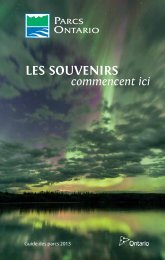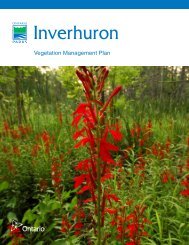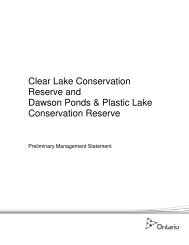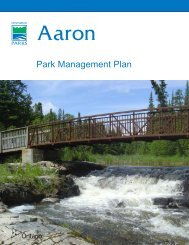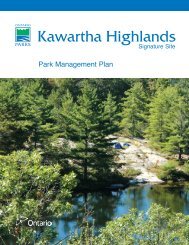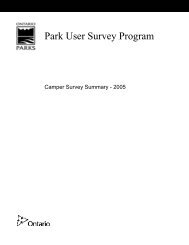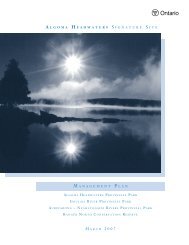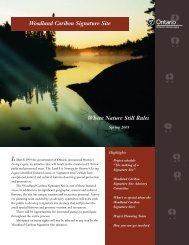Sandbanks Draft Veg Mgmt Plan - Ontario Parks
Sandbanks Draft Veg Mgmt Plan - Ontario Parks
Sandbanks Draft Veg Mgmt Plan - Ontario Parks
You also want an ePaper? Increase the reach of your titles
YUMPU automatically turns print PDFs into web optimized ePapers that Google loves.
IMPLEMENTATION SCHEDULE B – <strong>Plan</strong>tation Renaturalization <strong>Plan</strong><br />
Background and Site Description<br />
The West Lake Dunes were naturally forested until around 1850. Timber cutting and cattle<br />
grazing concentrated in the late 1800s destabilized the dunes and caused their migration<br />
inland. Some large cedar skeletons in the northwest portion of the plantation remain as<br />
evidence of this history. The area originally known as <strong>Sandbanks</strong> Provincial Park was<br />
established as a forestry station in 1921. Reforestation of the eastern portion of this sector<br />
from the 1930s to the 1960s prevented further migration of the dunes, but the unforested<br />
parts of the dunes remain active. The core plantation area covers approximately 80<br />
hectares, with 25% of that south of the road in the Richardson Campground area. This plan<br />
refers specifically to the plantation in the natural environment zone on the north side of the<br />
road.<br />
The entire plantation area is extremely patchy. Most of the area was planted in Scots Pine,<br />
with scattered individuals or patches of Jack Pine, Mugho Pine, Eastern White Pine,<br />
European Larch, Red Pine, Norway Spruce, and Black Locust. Large Cottonwoods are also<br />
present throughout, although it is not clear if these were planted. Some areas appear older<br />
than others, spacings vary, and the condition and size of the trees is very variable. The<br />
largest Scots Pines are approximately 20 – 29 cm diameter at breast height (dbh), although<br />
most trees are less than 15 cm dbh. In some sections where the Scots Pine have done well<br />
and are quite tall (> 10 m height), they are surprisingly straight and are perhaps marketable<br />
(although there is very low volume present). Most Scots Pine are unhealthy due to a<br />
number of factors including poor site quality, Pine Shoot Beetle, and Sirex Wood Wasp.<br />
Some Black Locust also appear unhealthy.<br />
Similarly, the understorey and ground cover are variable: in sections of dense pine, there is<br />
almost no understorey or ground layer of vegetation. In more patchy or open areas, young<br />
Scots Pine, White Pine, willows, Eastern White Cedar, Chokecherry, and White Birch have<br />
established to a limited extent. In the most open areas, aggressive pioneer species<br />
dominate.<br />
Deciduous species are moving into the edges of the plantation. In particular, the west side<br />
of the plantation is quite diverse and a variety of deciduous trees and shrubs are present.<br />
This area does not require active restoration.<br />
The entire site is ecologically fragile: the substrate is almost pure sand with a thin layer of<br />
organic material that is mainly composed of pine needles; many areas are diseased; and<br />
invasive or aggressive species other than Scots Pine are scattered throughout.<br />
Fire is a concern at this site. The increasing volume of standing dead timber and downed<br />
woody debris, as well as the extremely dry conditions, make the site vulnerable to fire.<br />
Unlike other types of areas requiring restoration in southern <strong>Ontario</strong>, fire will not enhance<br />
this site – it will destroy the very thin layer of soil and duff present and create open<br />
conditions too quickly to allow for renaturalization.<br />
The area is of unknown value to wildlife. The dense conifer areas likely provide winter cover<br />
to deer and other species. At least one canid den has been found in the plantation. Forest<br />
Bird Monitoring has not revealed any notable species and bird species diversity is relatively<br />
low. Hawks (Sharp-shinned, Coopers) have occasionally nested in the plantation in the<br />
past, and Wild Turkeys are often seen.<br />
<strong>Sandbanks</strong> <strong>Veg</strong>etation Management <strong>Plan</strong> A-2<br />
<strong>Ontario</strong> <strong>Parks</strong>, SE Zone<br />
2009



